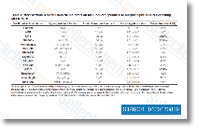After challenge with proteins leading to Synd1 shedding the cells had been fluo rescently stained implementing E cadherin and Synd1 precise FITC conjugated monoclonal antibodies. E cadherin is usually a key transmembrane component with the apical junc tional complex. In a very simple polarized epithelium the junctional supplier PF-00562271 complicated includes tight junctions and underneath lying adherens junctions taking part in a major role from the forma tion and servicing of epithelial barriers.We for that reason desired to see if the procedure of Synd ectodomain shedding observed in our experiments is accompanied from the reduction of intercellular contacts reflected inside the dissocia tion within the junctional complex. Our analyses unveiled evident cytopathogenic alterations in taken care of NMuMG cells. In all circumstances, a network of E cadherin noticeable in untreated confluent cells gets either disorganized, damaged or disappears from intercellular contacts upon therapy.
similar to what continues to be reported for VE cadherin in endothelial cells handled with LT.Partially conflu ent NMuMG selleck chemical DOT1L inhibitors cells show intensive Synd1 staining along the perimeter of cells, which partially or wholly disappears from cell surfaces following incubation using the shedding inducing proteins, even though remnants within the ecto domain stay visible inside the intercellular space.Notably, the treated cells retain a large intensity of DAPI blue fluorescence standard for undamaged nuclei, indicat ing that the loss of E cadherin and Synd1 will take place from viable cells. Inhibition of Synd1 release The ectodomain shedding of cell surface molecules is typ ically mediated by host metalloproteinase sheddases.The two constitutive and accelerated shedding are inhibited by a variety of substances lively within a variety of receptor and anxiety activated signaling pathways, which involve protein tyrosine kinases.
protein kinase C.and mitogen activated protein kinases.The exercise of LT in macrophages and epithelial cells  is previously reported to involve down regu lation of MAPK kinase cascades.The outcomes of inhibition experiments are presented during the Table. It shows that piceatannol, a particular inhibitor in the Syk relatives of PTKs is energetic in both spontaneous and induced Synd1 shedding for all tested proteins. During the case of AnlO and LT at low concentration of 0. five M the inhib itor shows some stimulatory impact on both constitutive and induced shedding, but it strongly inhibits Synd1 release in concentrations normal for its action range of 5 to 50 M.The result of piceatannol suggests that all four variables stimulate signaling pathways, which most quite possibly involve cytoplasmic Syk, having said that piceatannol has also been reported to inhibit other tyrosine kinases in the comparable concentration range. In agreement with the over suggestion the inhibitor of Src PTK family members PP2 is totally inactive.A
is previously reported to involve down regu lation of MAPK kinase cascades.The outcomes of inhibition experiments are presented during the Table. It shows that piceatannol, a particular inhibitor in the Syk relatives of PTKs is energetic in both spontaneous and induced Synd1 shedding for all tested proteins. During the case of AnlO and LT at low concentration of 0. five M the inhib itor shows some stimulatory impact on both constitutive and induced shedding, but it strongly inhibits Synd1 release in concentrations normal for its action range of 5 to 50 M.The result of piceatannol suggests that all four variables stimulate signaling pathways, which most quite possibly involve cytoplasmic Syk, having said that piceatannol has also been reported to inhibit other tyrosine kinases in the comparable concentration range. In agreement with the over suggestion the inhibitor of Src PTK family members PP2 is totally inactive.A
SiRNA Library
SBI's GeneNet RNAi Libraries are a pooled set of shRNA
